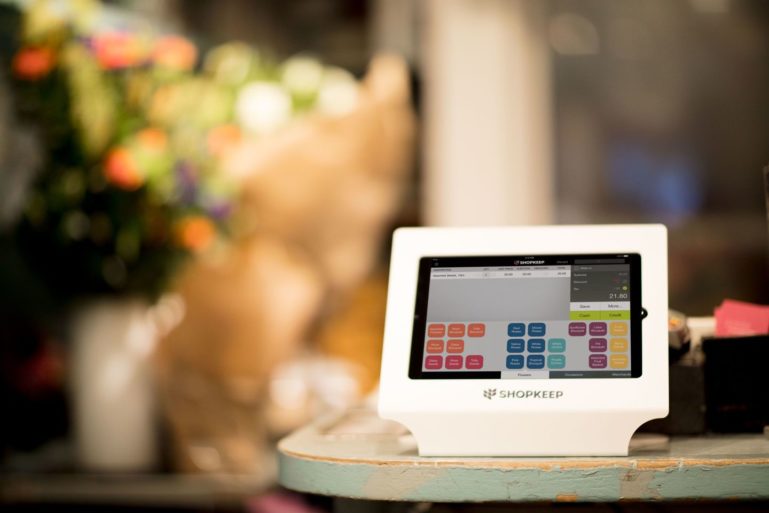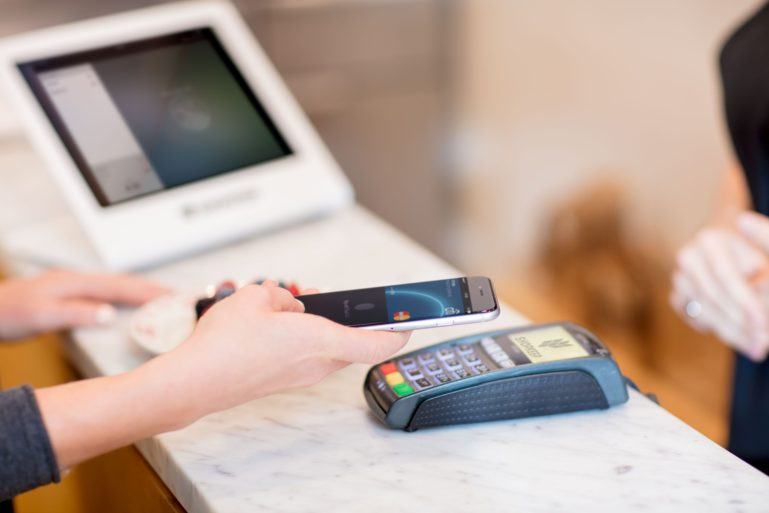
How to Turn Your iPad into a Cash Register
If you’re a small business owner, an iPad can be a powerful tool.
It can be used as digital signage, a customer service tool, a demonstration device and you can even turn your iPad into a cash register. That’s right, one of the earliest staples of any brick and mortar store, the century-old cash register, is quickly being replaced by an iPad – a device that has not yet reached its tenth anniversary. So how did this ‘new’ device swoop in and take over something as irreplaceable as a cash register? The most obvious answer is technology. The less obvious answer is, you, Mr./Mrs./Miss Small Business Owner. You have helped drive the evolution of tablet-based business management tools through demand for enterprise quality software and devices on a small business budget.
One of the biggest strides the iPad has made in business management is dominating the mobile point-of-sale (MPOS) space as the preferred device for a cash register system. 44 percent of all stores use MPOS, and 79 percent of those are small to midsize businesses just like yours. Why, you ask? Because it’s easy. Ease of use is one of the most important factors to consider when choosing a POS system, so it’s no wonder iPads are leading the way.
Before you go out and download just any iPad point-of-sale app or cash register from the App Store, you first need to understand how you can fully leverage an iPad and turn it into a sophisticated tool that is more than just an electronic cash register (ECR).
Electronic Cash Register VS. iPad Cash Register
While the original cash register was invented in the late 1800’s, we still had to wait half a century before the electronic cash register was available. It wasn’t until the 1970’s, with the introduction of barcode scanners and UPC codes, that the ECR would start to shape into the system we recognize today.
The electronic cash register offered significant advancements over the old mechanical cash register of yesteryear. You could now use a barcode scanner to scan an item’s UPC code and make it appear in the order on the monitor in front of the cashier. The computer within the ECR would connect to the company’s network and provide inventory tracking and reporting – albeit a far cry from today’s analytics and inventory management systems, but for the time, it was pretty groundbreaking stuff.
SEE ALSO: Goldilocks Syndrome? 3 Types of Cash Registers to Choose From
There were two problems with this model. First, most small businesses on main street didn’t have a computer network because it wasn’t a necessity at the time and it was much too expensive for the average mom-and-pop shop to afford. So, unless you were buying an enterprise point of sale system, your business was likely running on traditional cash registers for the better part of the last 40 years. Second, these glorified cash registers require a lot of manual reporting and tracking on behalf of the retailer, making it difficult to justify spending so much money on something that provided little value, a little bit absurd.
Fast forward to the last decade when Apple and Steve Jobs reinvented tablet computing, and suddenly there is an influx of startups and legacy companies eager to develop and hone their software to take full advantage of iPad’s power and affordability to the small business market. Yes, ShopKeep is one of those startups, and we are damn proud of it! Our roots in the retail industry, born out of the frustration with ‘traditional’ POS systems,’ lead to the birth of ShopKeep, the #1 rated iPad point-of-sale – but we digress.
Modern-day cash registers are better known as point of sale systems. They are most commonly found “in the cloud” (meaning your data goes out to an off-premise server, which saves you money on network hardware) and at all levels of business – small, midsize and enterprise. However, it’s not the hardware that delivers the most value – it’s the software.
Software built to turn your iPad into a cash register is really where you’re going to get the most bang for your buck. It will become the focal point of speed and accuracy of checkout, the core of your inventory management system, employee management system, vendor management, and most importantly your business reports.

How to Choose an iPad Cash Register System
Like most things, all is not created equal. The same holds true for iPad POS systems. However, before you can judge one system over the next, you need to take a look at your own business and determine your specific needs. After all, if your needs are ABC and you purchase a system that only does XYZ, you only have yourself to blame.
Take the time to do the research. What works for another business may not work for you – even if it’s the same industry. No one knows your business better than you! Sit down and make a list of nice-to-have features and must-have features and use that as your starting point.
Download Our Choosing a POS System Guide to Learn How to Find the Right System for Your Business.
Besides your business specifics, there are also generalizations that can be made when it comes to selecting an iPad POS system. Here are some ideas to get the thought process started:
Vendor Selection. Choosing a vendor, or company to purchase an iPad cash register is going to be your next step after you’ve made your list of nice-to-haves and must-haves. POS systems are typically sold one of two ways.
1. Direct. With a direct model, you are purchasing the system directly from the software developer. They create the software, deliver the product, support any hardware used with it, such as the iPad stand, cash drawer, or receipt printer, and offer varying levels of customer service and support for their product, ideally, 24/7/365. They are also responsible for managing software features and updates.
2. Value Added Reseller (VAR). A VAR is a person or company that has a relationship with the software developer to sell third-party products to the end user, or merchant. Typically they serve a local or regional market, and when required they may even conduct onsite setup and installation. However, customer support is usually limited, and they do not have any say in what happens or goes on with the software itself.
References. Along with vendor selection, you also want to consider reference.. Who else uses the POS system and what has their experience been? Companies can promise a lot of things online, but can they actually deliver?
Support. Small businesses are typically not your typical Monday through Friday, 9-to-5 operation. So, on a Saturday afternoon when your store is jam packed with back-to-school shoppers, and there’s a snafu with the POS system, you want to make sure there is someone you can call. Or a resource at your fingertips that will help you troubleshoot the problem. As a small retailer or restaurant owner, there is no better reassurance than 24/7/365 customer support.
Reporting. This is crucial in your selection process. If a point of sale system doesn’t provide the reports you need to analyze the performance of your business, what’s the point of having one? In today’s data-driven culture where you can measure just about everything, you need to make sure the system you choose has robust reporting and most importantly the reports you need.
Integrations. According to a study released by Intuit, 82 percent of small businesses use an average of 1-6 web or mobile-based software applications. If a few of these apps can integrate with your iPad POS system, the way ShopKeep integrates with accounting solution QuickBooks and ecommerce platform BigCommerce, it will save you time and help streamline day-to-day business operations.
The Anatomy of an iPad Cash Register
When you turn your iPad into a cash register, you’ll need a few more additional pieces of equipment to make it a fully functioning POS system. Let’s take a look at what some of those other essentials are in addition to the actual iPad and software application.
iPad. You can’t have an iPad cash register without the actual iPad. Most POS providers will also offer an option to purchase an iPad through them, or you can bring-your-own-device (BYOD).
POS Software. The software is the brains behind the whole operation. It calculates your sales, tracks inventory, employee hours, customers, vendors, and so much more. Without the POS software, your hardware would be meaningless.
Cash Drawer. No cash register or POS system is complete without a cash drawer. People still use cash, and you need to have a safe place to store it during each shift.
Printer. Even though receipts via email are becoming increasingly popular, many small businesses and their customers still prefer paper receipts over the digital version.
Barcode Scanner. Depending on the nature of your business, a barcode scanner can be considered more of an option rather than an essential. Retail stores are more likely to use a barcode scanner because all of their items have UPC codes and there are literally thousands of them. Having to search for and manually enter each item at checkout makes the process more time-consuming. On the other hand, a bakery or cafe may not use one because they are mostly selling fresh goods that don’t have UPC codes and their inventory tends to be much smaller than a retailer’s.
Payment Integration. Like most businesses, you’ll need to accept credit cards, debit cards, and gift cards. The best way to do this without creating an accounting nightmare is to have those payments integrated into your iPad point of sale system. This way your POS can account for all payment types to make reconciliation and reporting a breeze.
Benefits Of Turning Your iPad into a Cash Register
Like we said in the beginning, an iPad can be a powerful tool for small business owners. When you turn your iPad into a cash register or point of sale system, you’re turning the corner into a whole new world filled with freedom and flexibility. There are so many areas of your business that can be streamlined and optimized by using an affordable and dynamic tool such as the iPad.
Employee training is easier and less time-consuming. Why? Because 77 percent of all Americans use smartphones and the same operating principles used on those phones apply to tablets. For example, if you swipe left to delete an email, you can also swipe left to remove an item from an order. The learning curve will be significantly less with an iPad than an electronic cash register which makes it much easier to use.
Inventory management is another area that benefits from using an iPad POS system. Inventory is updated in real time, and you can set order triggers to let you know when you’re getting low on an individual item, and it’s time to place another order with the supplier. This will help ensure you never run out of your top selling products and leave customers disappointed.
Speaking of customers, there is no better place to track them than in your POS system. You can keep track of what they purchase, when they purchase, the average amount spent, and even know who your top customers are. So, if by chance you did miss an inventory notification and one of your best customers comes in looking for the item that’s out of stock, you can make a note to email them when the item ships in and send along a discount promo for their troubles.
Last but not least, turning your iPad into a cash register is affordable. You don’t have to break the bank to get a robust iPad POS system that will cost hundreds of dollars a month. For instance with ShopKeep, your cost is a little as $2.50 a day. In the grand scheme of things, $2.50 is about the cost of that cup of coffee you bought on the way into the store today. If you can afford a cup of coffee, you can afford an iPad cash register system.
Finding ways to turn your iPad into a cash register doesn’t have to be a daunting task, you just need to know what to look for so that you get the most for your money. Hopefully, this will help jumpstart your research and identify what to look for in an iPad cash register system.
Ready to take your business to the next level? Put your cash register on an iPad with ShopKeep’s simple, intuitive, iPad cash register system.
Want to try ShopKeep for yourself?
Just answer a few easy questions.
Need help finding the right point of sale?
Just complete the form. We’ll call you right back to explain how ShopKeep can work for you.
Hit the ground running.Sprinting, in fact!
Read our free, comprehensive guide, Small Business 101, to learn all you need to know about starting a thriving business.

